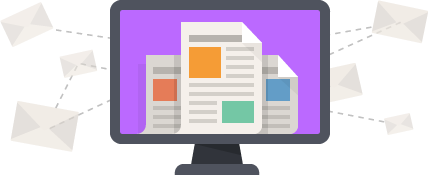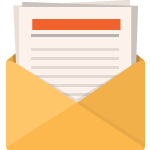THE CYBORG GUIDE TO AI COPYWRITING
A Comprehensive Guide To AI Copywriting For Writers, Freelancers, and Solopreneurs
In this 4-part guide, we’re going to cover four important topics:
- Why AI Has Permanently Changed Copywriting
- How To Write Profitable Copy With AI
This is the practical part of the guide. Click above to navigate to Part #1 and read the conceptual part.

Part #2: How To Write Profitable Copy With The Help Of AI
Click below to skip straight to the desired section:
- What Is AI Copywriting?
- The Benefits Of AI Copywriting
- The Limitations Of AI Copywriting
- The Cyborg Writing Process
- Phase #1: The Preparation Phase
- Phase #2: The Writing Phase
- Phase #3: The Editing Phase
Or simply continue reading below…
Who Is Jacob McMillen (aka The Cyborg Writer)?
I’ve spent the last 11 years as a copywriter, content marketer, and solopreneur — turning writing into around eight figures worth of net profit for my clients and my own businesses. I’ve also spent thousands of hours creating guides (like this one) that help people earn more through writing. Around 300k people visit these guides each year.
I’ve been studying, investing in, and advising on the AI space since 2020, but the launch of GPT4 in 2023 shifted this from a side-interest to a full-time focus. Regardless of how you feel about AI, it WILL be exploited by large market players, and it’s my goal to help individuals (writers, freelancers, entrepreneurs, etc.) become AI’s chief beneficiaries.
What is AI Copywriting?
AI copywriting is the process of leveraging advanced machine learning algorithms, particularly those specialized in natural language processing, to generate written content.
The recent revolution in AI copywriting is the result of a new generation of AI tools that are exceptionally good at mimicking human writing, for two distinct reasons.
First, the writing produced SOUNDS human.
The natural language processing used in these tools creates content that even linguists are unable to differentiate from human writing.
Second, the idea association is exceptional.
The content of the writing produced fits the subject matter and often does a more comprehensive job of covering associated ideas than a human would.
These new AI tools are trained on MASSIVE datasets that include huge portions of the internet. Their primary goal is to emulate human-like writing patterns and styles, offering a blend of creativity and efficiency with a wide variety of applications.
But before we start learning those applications, we need to understand the benefits and limitations of these tools.
The Benefits Of AI Copywriting
Like with most software, the benefits of using AI for copywriting are connected to speed, efficiency, and scalability.
1. AI can help with brainstorming.
A big part of copywriting is generating large numbers of ideas that can then be whittled down to a few great options and refined from there.
For most humans, brainstorming requires a good deal of time, and it can even be a painful process as we attempt to push past the mental ruts and patterns that develop over a brainstorming session.
For AI, this process is virtually instant and can often produce both the quantity and variety of ideas that we are seeking in a brainstorming session.
Using AI will help you brainstorm more efficiently.
2. AI can create great content structure.
A big part of content and copywriting is structure — creating a strategic framework that delivers the right message in the right order to help guide the reader toward your desired action.
For creating content, AI’s exceptional pattern recognition allows it to create more comprehensive article structure than 95% of the writers I’ve worked with over my 11 year career.
For direct-response copywriting, AI is quite good at following a proven copywriting framework when provided with one.
Using AI will immediately improve your ability to structure content.
3. AI can complete smaller writing tasks instantly.
Every copywriting project is a combination of numerous, small writing tasks.
You don’t simply “write an article”. You first write a headline, then you create an outline, then you write subheaders, then you write a paragraph, then you write another paragraph, then you write a bulleted list, then find a case study to reference, etc.
Many of these small writing tasks can be assigned to AI copywriting tools and performed at a fairly competent level.
The competence of these tools is partially a factor of their unprecedented ability to write human sounding language and cover the right ideas (as we discussed earlier). But a large part is simply a matter of speed. You can have AI generate 10 versions of any given writing task in a few seconds, and then you can pick and choose the pieces that you like best.
Using AI will help you complete low-impact writing tasks rapidly, freeing up more time to focus on higher-impact tasks.
4. AI can raise your writing floor.
Human writers carry a unique collection of strengths and weaknesses, and AI can help mitigate some of these weaknesses and raise the overall floor of your writing.
Common weaknesses included content structure, grammar and typo problems, issues connected to writing in a second language, difficulty writing at or below a 10th-grade reading level, and many more.
AI can be used during the writing process or have writing fed into it during the editing process to counteract these issues and improve the writing at minimal time and cost.
Using AI will help solve common writing problems and raise the floor of your writing.
The Limitations Of AI Copywriting
While the benefits of AI for copywriting are groundbreaking, AI copywriting tools are just that — tools — and like any tool, they come with critical limitations.
1. AI can’t complete complex writing tasks.
While AI is notably competent at smaller, simpler writing tasks, it increasingly struggles to provide usable help the more complexity we add to the task.
For example, if we ask AI to create each component of a blog post individually, it can do a decent job. However, if we ask it to write a full blog post, what it produces will be virtually worthless.
Similarly, while AI is great at summarizing general information, it struggles as we ask it to go deeper and provide a specific point of view or explore a deeper, more nuanced look into a specific topic.
2. AI doesn’t understand marketing objectives.
The most critical limitation of AI from a copywriting standpoint is its inability to understand marketing objectives. Content strategy is complex, and aligning content with the right marketing objectives is the difference between that content being profitable or being entirely worthless.
AI copywriting tends to miss the mark on resonating with the intended audience and driving the desired action. It will often produce content that is technically correct but fails to evoke the desired response from the reader.
3. AI struggles with evidence-based writing.
Higher level content and copywriting often leverages evidence to make a more persuasive argument. This evidence can be pulled from social proof, news, studies, or any number of sources, and when taking this approach, both accuracy and relevance are key.
Because AI writing tools are designed to give human users what they expect to see, they will often fill in fake or irrelevant evidence to complete a piece of writing. AI lacks the capability to conduct independent research, verify sources, or provide a well-rounded perspective on contentious topics, and its reliance on pre-fed information limits its ability to produce evidence-based writing.
4. AI struggles with real-time information.
A large percentage of online content is devoted to real-time information, events, and trends. Current AI models are built on pre-fed datasets and attempts to integrate them with real-time search have been fairly poor, which means these tools are nearly worthless at helping you cover anything that has recently happened or is happening in real time.
As we covered in Part #1, the most generation-defining result of the current AI revolution will be some form of AI-assisted search replacing the Google search model, but until that happens, AI tools will continue to struggle with real-time information.
Become A Cyborg: Write Copy With The HELP Of AI
Now that we’ve covered what AI can and can’t do when it comes to copywriting, it should be fairly clear that AI tools are incapable of producing profitable copywriting assets when left entirely to their own devices.
AI is most powerful as a copywriting tool when it’s in the hands of a capable copywriter.
I call this “AI-assisted writing” or to have a bit more fun with it, “Cyborg writing”.
Through the Cyborg writing process I’ve developed for my own work as a copywriter, I’m able to create writing assets 3-4 times faster than I was able to prior to AI, without a drop in quality.
It’s hard to conceive of a future where this isn’t the new normal. Imagine trying to compete with a copywriter who can do the same thing you can do in 25% of the time (click here for more on the future of copywriting).
Through the rest of this guide, I will be showing you how to apply AI technology to your own copywriting process through the three phases of writing:
- Preparation
- Writing
- Editing
For the purpose of this guide, I’m going to be using ChatGPT Plus with GPT4 enabled. I will talk more about why in Part #3 of this guide where we cover the best AI copywriting tools, but for now, I’ll just address the two most important reasons.
First GPT4 is 100% essential to get great results from AI Copywriting. GPT3 and GPT3.5 are okay, but nowhere close to GPT4 in terms of capability.
Second, while you can access GPT4 in other ways — OpenAI’s playground or any number of 3rd party tools built on top of GPT4 — I have yet to try any tool that does a better job or can handle a wider variety of use-cases than ChatGPT.
With that said, let’s get started.
Phase #1: AI Copywriting In The Preparation Phase
In order to begin writing any sort of copy, you need to know what you are wanting to create and the marketing objective you want to accomplish.
If you want to write a blog post, you are simply going to tell those two things to ChatGPT and request an outline.
What’s a good outline for a blog post on [topic] aimed at [desired marketing objective]?
It’s that simple. You don’t need a complex prompt to get a solid outline.
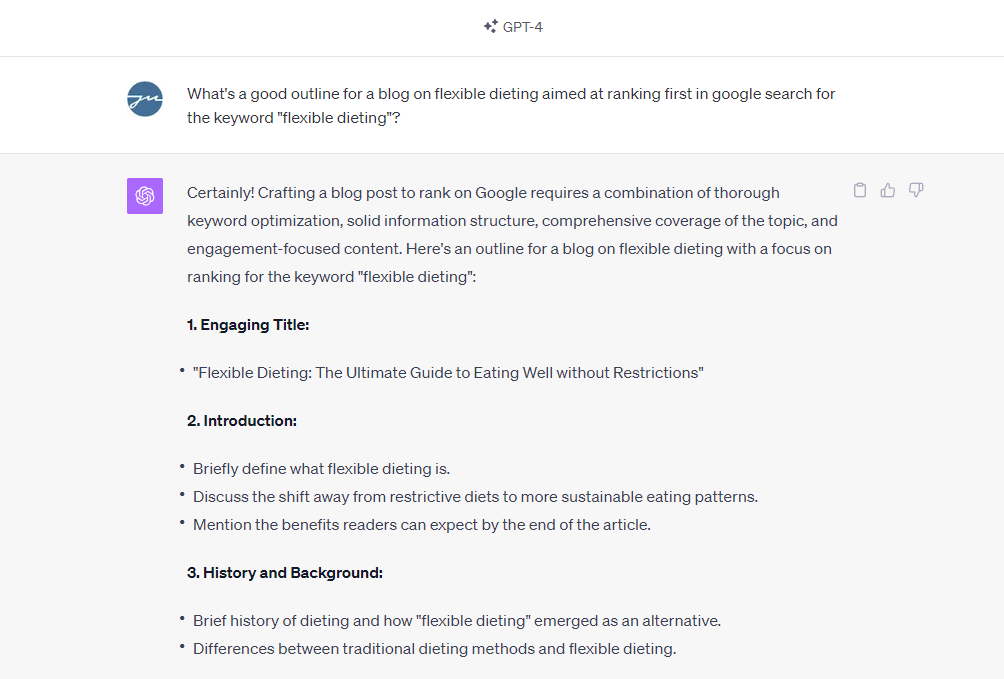
You now have two options:
- Use the provided outline as-is and move on to the writing phase.
- Make some manual adjustments to the outline.
If you decide to make adjustments, you’ll need to take one additional step. Enter the revised outline back into ChatGPT and ask it to reply “YES” to acknowledge you’ll be using this revised outline. You are then able to move into the writing phase.
For most other deliverables, there’s a few more steps involved.
Let’s say we want to write a sales page.
We’re going to need a lot of specific information in order to write that page, and we want to share that information with ChatGPT.
In a minute I’m going to ask you to help me write [deliverable] for [product or service]. Before we begin, I want you to fully understand my business, offer, and customers.
Ask me at least 20 questions about my business, customers, [product or service], and anything else you need in order to help me create the best possible [deliverable].
From here, ChatGPT will provide you with a pretty solid questionnaire to answer.
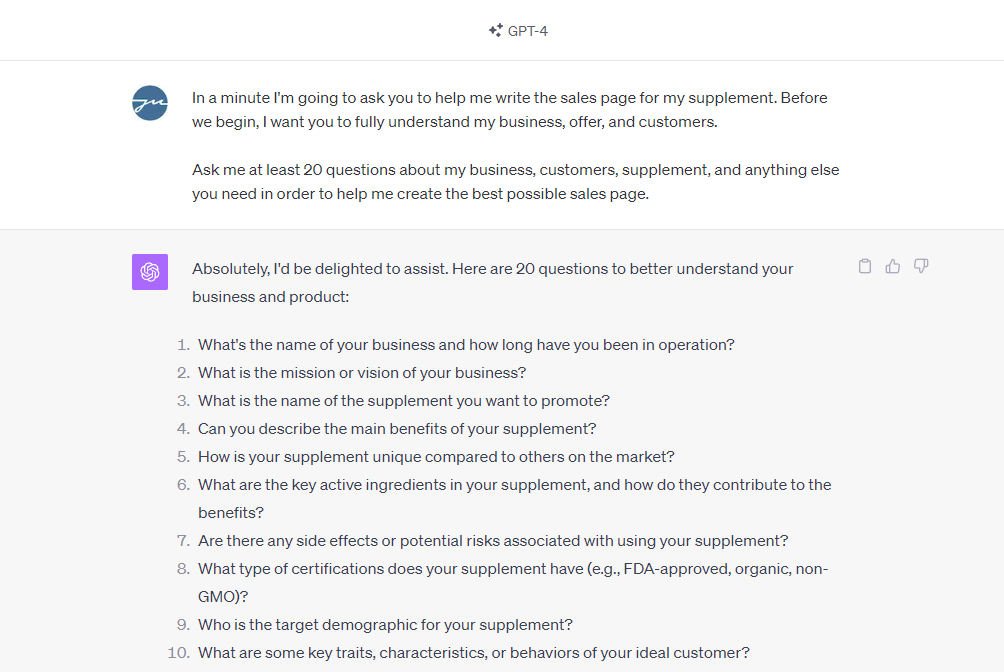
You will need to enter the answers to all these questions back into ChatGPT. What we are doing here is “seeding” this ChatGPT thread with a large amount of relevant data for it to pull from as we move into the writing phase.
You can also use my personal copywriting questionnaire and then simply enter the answers to that into ChatGPT.
In an ideal world, you will have all the answers to these questions ready to go and sourced straight from an existing customer base.
After all, the best copy is always pulled straight from real customer feedback.
Unfortunately, life is rarely ideal.
There’s a lot of reasons you might not have any customer feedback to work with.
- It’s a new business.
- It’s a new product or service.
- The business is pivoting in a new direction.
- The business owner hasn’t done a good job of collecting feedback.
If you need to do a bit of research, AI can help.
This is one of the few places in this article where I’m going to steer you away from ChatGPT. Despite its repeated attempts to make live browsing a part of its tool in collaboration with Microsoft, this functionality remains weak.
Instead, I’m going to have you use Perplexity, which is currently the only genuinely useful tool I’ve found for generative search with sources.
You’ll then prompt Perplexity by asking about the challenges faced by your target audience.
You can do a general search that incorporates the “entire internet”, but for this purpose, I like to click the “Focus” button and isolate my search to Reddit.
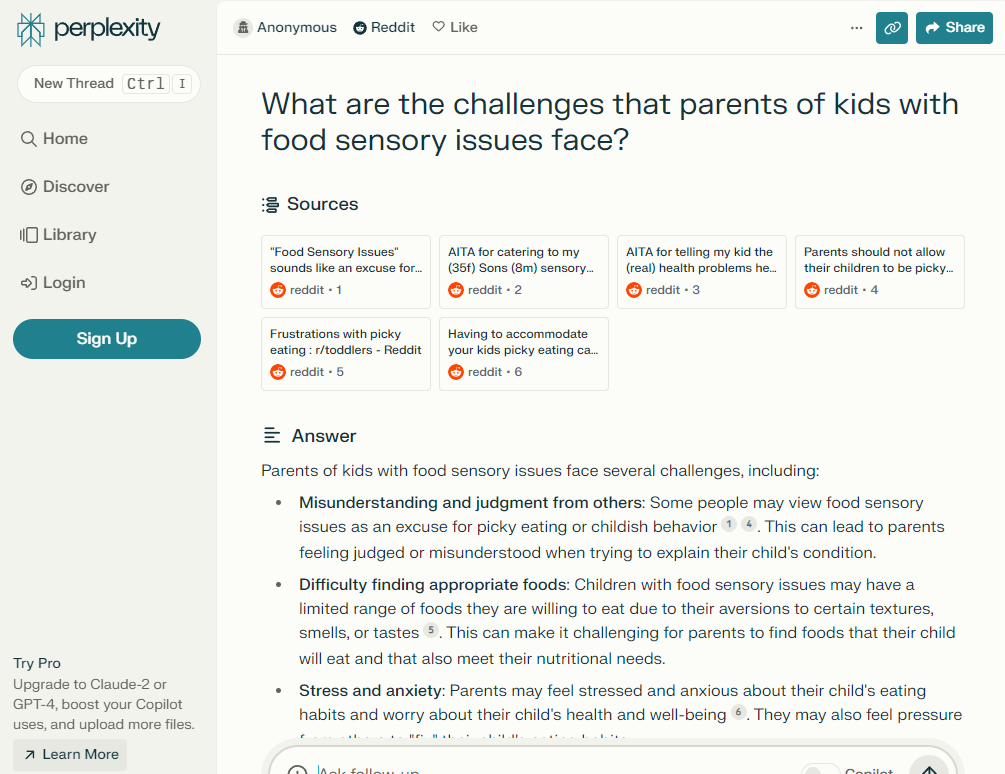
Perplexity will then provide you with AI-written answers sourced directly from real Reddit threads — hopefully threads where your real target audience is having a conversation about issues related to your product or service.
You now have the best possible answers to your copywriting questions that can be sourced without an existing customer base.
Once you’ve entered all the answers to your questions into the ChatGPT thread, there’s one last step before you’re ready to write.
You need to enter the copywriting framework that you’ll be using for the deliverable.
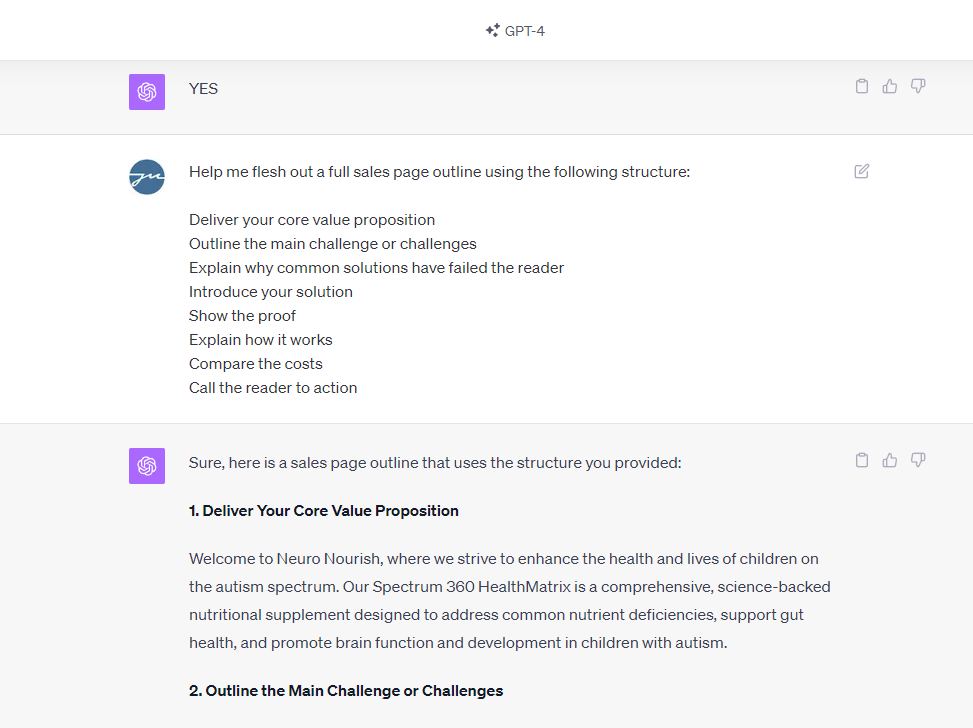
You can do this by asking it to create an outline around a named copywriting framework (like the AIDA framework), by entering the framework sequence yourself (like I did in the screenshot above), or by asking ChatGPT to recommend a framework.
The only requirement is that you get ChatGPT to list out the framework sequence for your page as an output in the thread, so that you can reference that sequence in the writing phase.
If that’s a little confusing, don’t worry, it will make sense in just a moment.
Phase #2: AI Copywriting In The Writing Phase
It’s time to write!
The biggest mistake that most people make at this point is asking ChatGPT to write the full blog post.
Don’t do that. You’ll get something short and unusable.
Instead, you’re going to copy the first section of the outline or framework in the thread, paste it into a new prompt within that same thread, and ask ChatGPT to write the section.
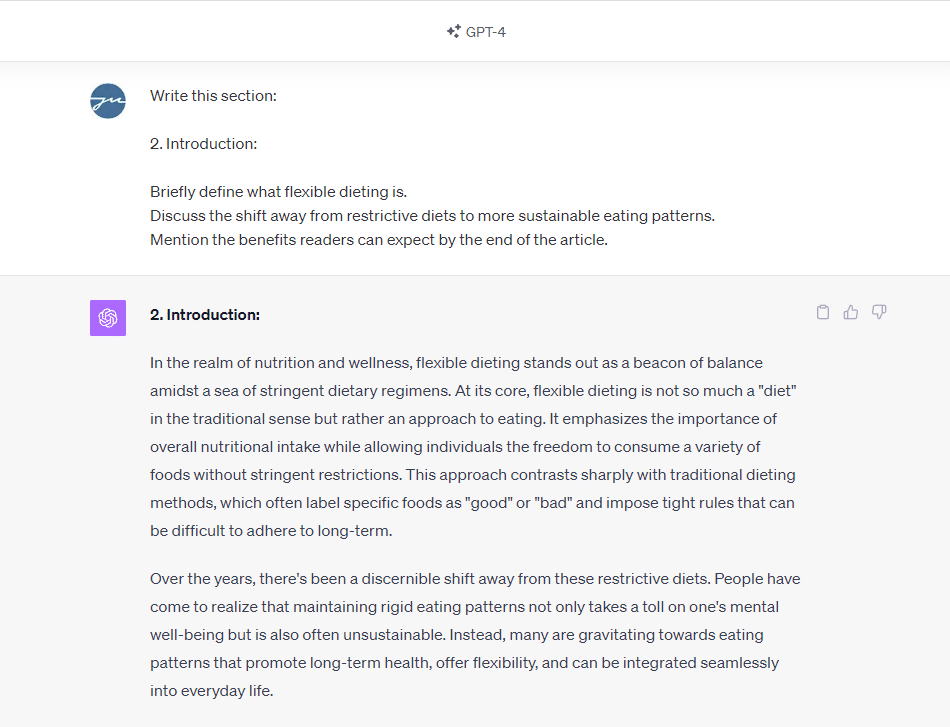
This is where it is CRITICAL that you have the outline of the blog post or deliverable sitting in the ChatGPT thread. If you don’t, ChatGPT will attempt to turn each piece of your copy into a standalone deliverable rather than writing it as a piece of a larger deliverable.
Once you have the section written, take a look at it.
Think about what you like or don’t like about what ChatGPT has written.
Let it fuel your own ideas about what you want to include in this section.
You have two options from here:
- Paste it into your working document to be manually adjusted later.
- Re-prompt ChatGPT with a specific request.
If the copy is pretty close to what I want OR I have a crystal clear idea of what I want to say instead, I’ll simply paste ChatGPT’s copy into my document, add some notes, and move on to the next section.
If I have a rough idea of what I want and it’s quite a bit different from ChatGPT’s text, I will reprompt and try to dial it in.
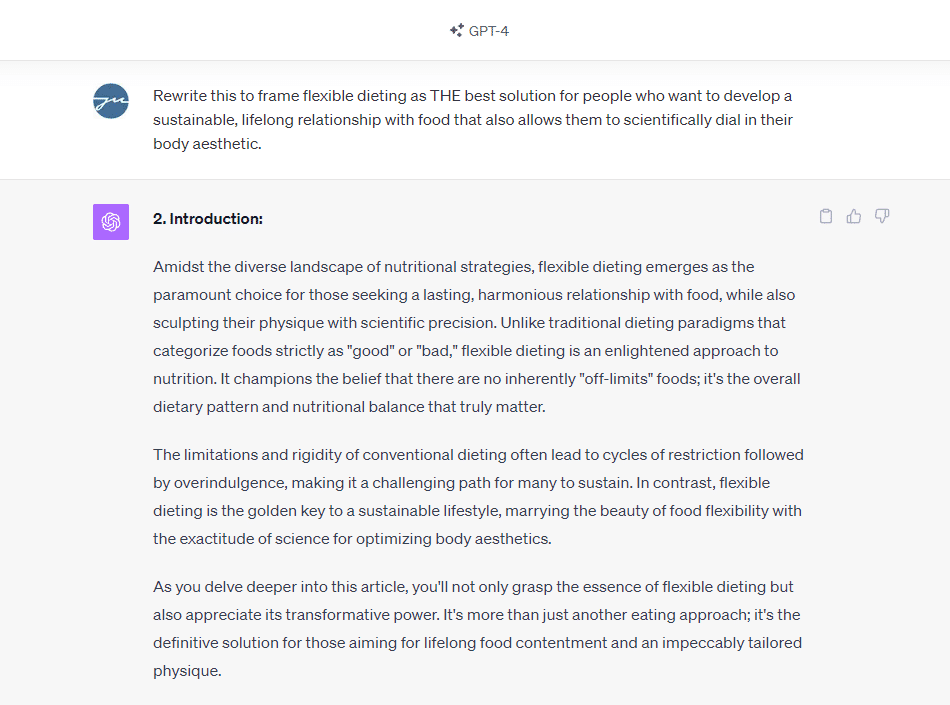
You might notice that ChatGPT’s language choices here are a bit awkward. We’ll fix that in the editing phase.
For now, we want to stay focused on the substance of the piece.
Once you have roughly the type of content you want for one section, repeat this process for each section of the copywriting deliverable.
Congrats, you now have a passable first draft… in what… 10 minutes?
Wild.
But also worthless if we stop here.
Now it’s time to make this AI copywriting deliverable amazing.
This is where creativity and mastery come into play — mastery in copywriting, mastery in marketing, and mastery of the tools themselves.
A lot of the things that you can do here will have nothing to do with AI:
- Interviewing a customer and including their firsthand account
- Reaching out to subject matter experts and getting their input
- Adding in graphics, videos, or other visual media
- Running a survey to collect original data
That said, I’ll include a couple tricks you can do with AI here.
For blog posts, one of my favorite things to do is ask ChatGPT for examples and analogies. This is the type of writing addition that is highly beneficial but time-consuming to do manually.
GPT4, on the other hand, can create exceptional examples and analogies in seconds.
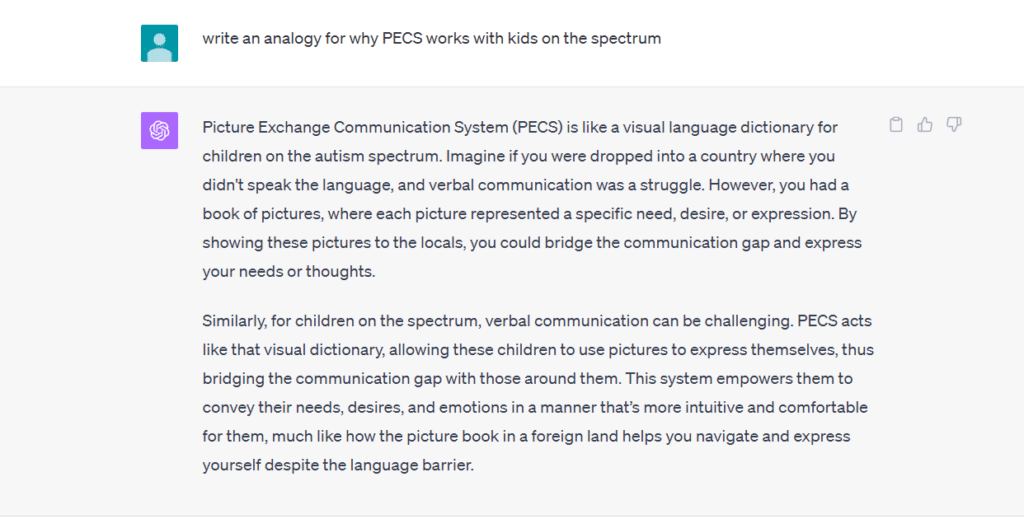
Stuff like this helps readers quickly understand a new concept by attaching it to a familiar one. It’s an incredible teaching device and has been used effectively long before AI.
For sales deliverables like ads, landing pages, and emails, I like to use ChatGPT to help me add emotion to my sales stories.
For example, here’s a prompt I put in while trying to flesh out a founder story.
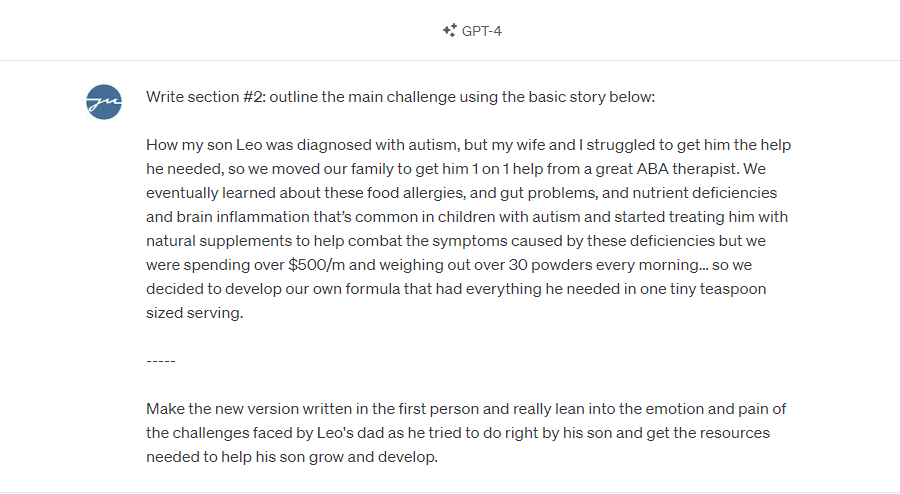
And this is the first part of what ChatGPT gave me.

That’s a pretty compelling story, and I want to highlight that last line in particular:
“It felt like an unseen enemy was attacking him from the inside, derailing his progress and dimming his spirit.”
That’s the type of line that sells stuff. It’s emotional, visual, and personal.
If it took you two hours to write that line, it would be worth it, and ChatGPT delivered it for free.
When you approach AI copywriting with an eye to pull value from it wherever you can, while still expecting to have to do a lot of work yourself, that’s where AI can really make a tangible difference and contribute to profitable copywriting.
If you found this section helpful and want me to walk you through every trick in my toolkit while you watch over my shoulder as I create a real blog post, sales page, email sequence, and video script, click here to learn more about Copywriter 2049.
Phase #3: AI Copywriting In The Editing Phase
Once you’ve completed your second draft and included all the components that will make your copywriting exceptional, it’s time to go into the editing phase.
For starters, ChatGPT is a solid proofreader.
I like to have it review my finished draft and line item any needed changes.
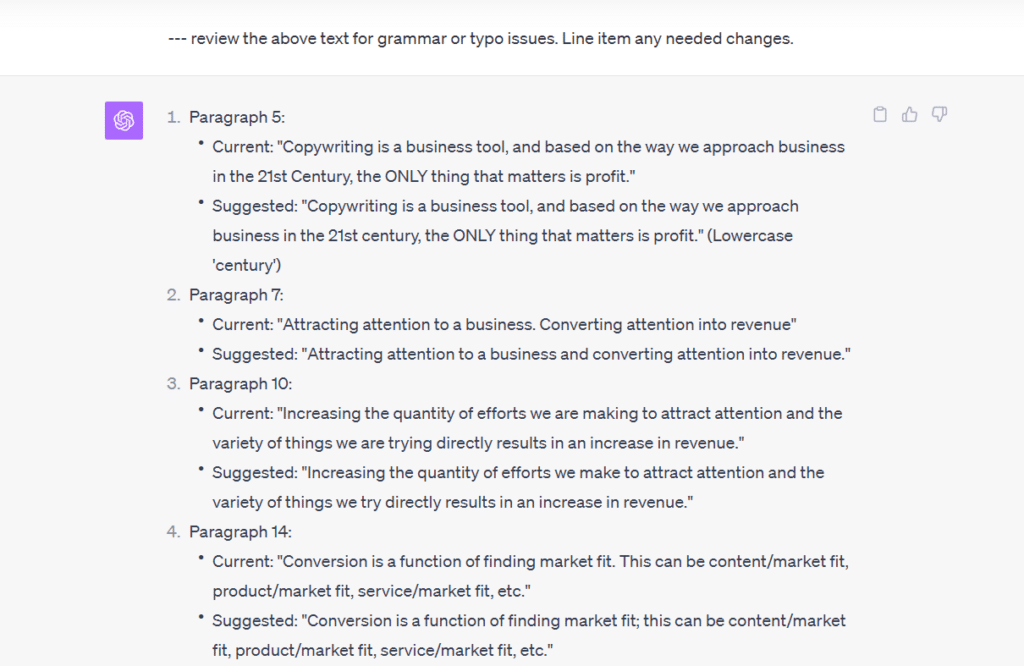
It will catch the typical typos and grammar. This functionality has existed for years with other tools, but it’s convenient to have it done via ChatGPT.
Plus, ChatGPT brings quite a bit more editorial value to the table than basic proofreader.
For starters, ChatGPT will make suggestions on language and phrasing to improve clarity.
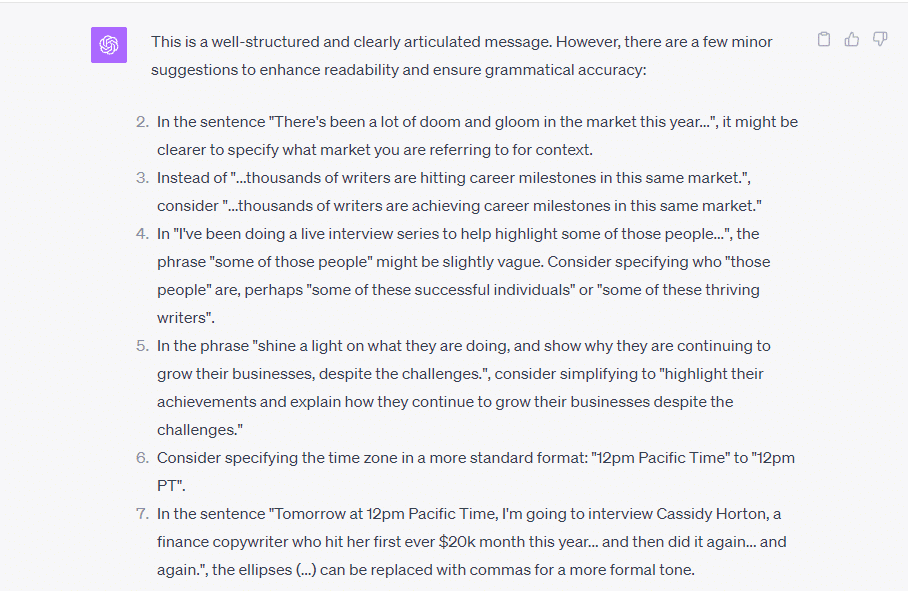
If you look at the above batch of recommendations, each one is focused on issues that aren’t technically wrong but could be improved to make things more clear for the reader.
Clarity is a CRITICAL goal for copywriting and one of the BIGGEST struggles that new copywriters have.
In a similar vein, ChatGPT can edit an entire piece of text to bring it to a desired reading level. Studies over the years have shown that writing around an 8th to 10th grade reading level is ideal in most situations.
As an avid reader who has always really struggled with simplifying my language in copywriting, I find this feature incredibly helpful, both for my own writing and for simplifying ChatGPT’s outputs when it starts sounding like an overexcited Lit major.
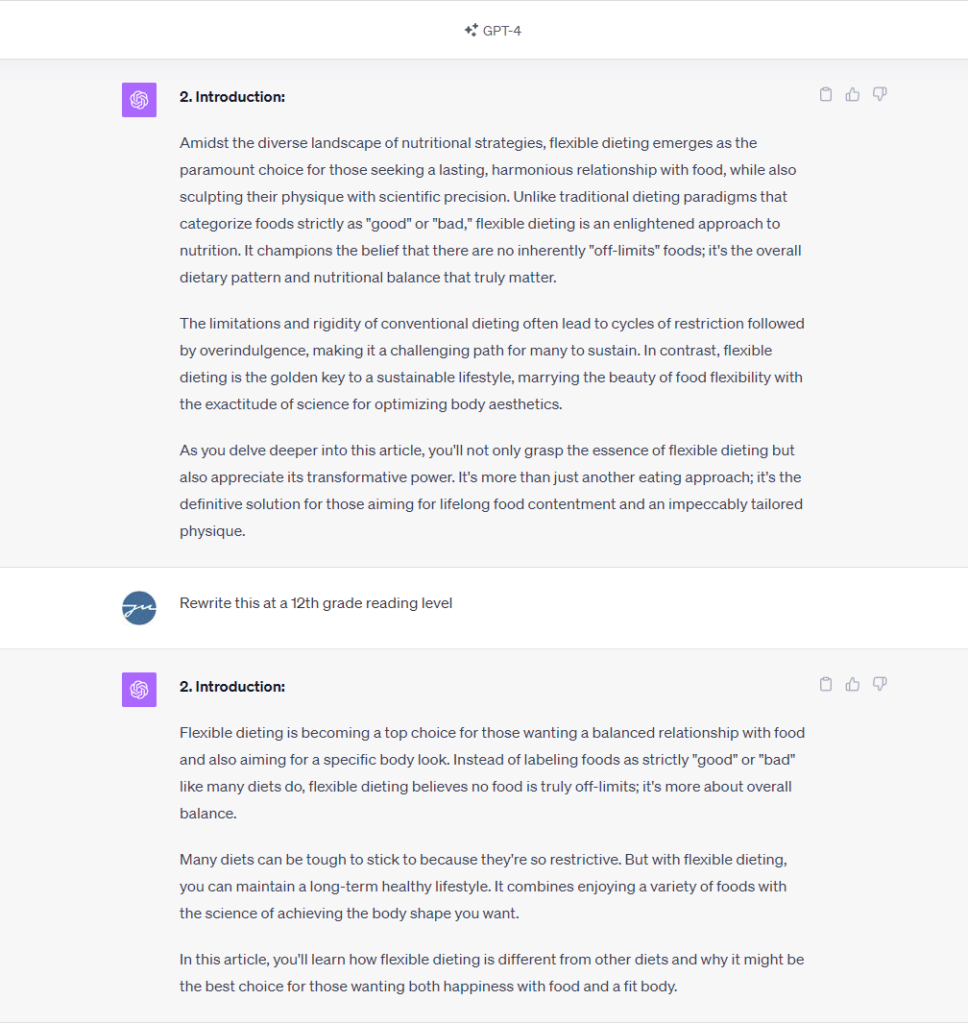
As you can see from the above screenshot, ChatGPT does a really solid job of preserving the core meaning of the content while adjusting the language to fit the requested parameters.
The final thing I like to do in the editing phase is copy and paste the entire text into ChatGPT and ask for suggestions on how I can improve the text.
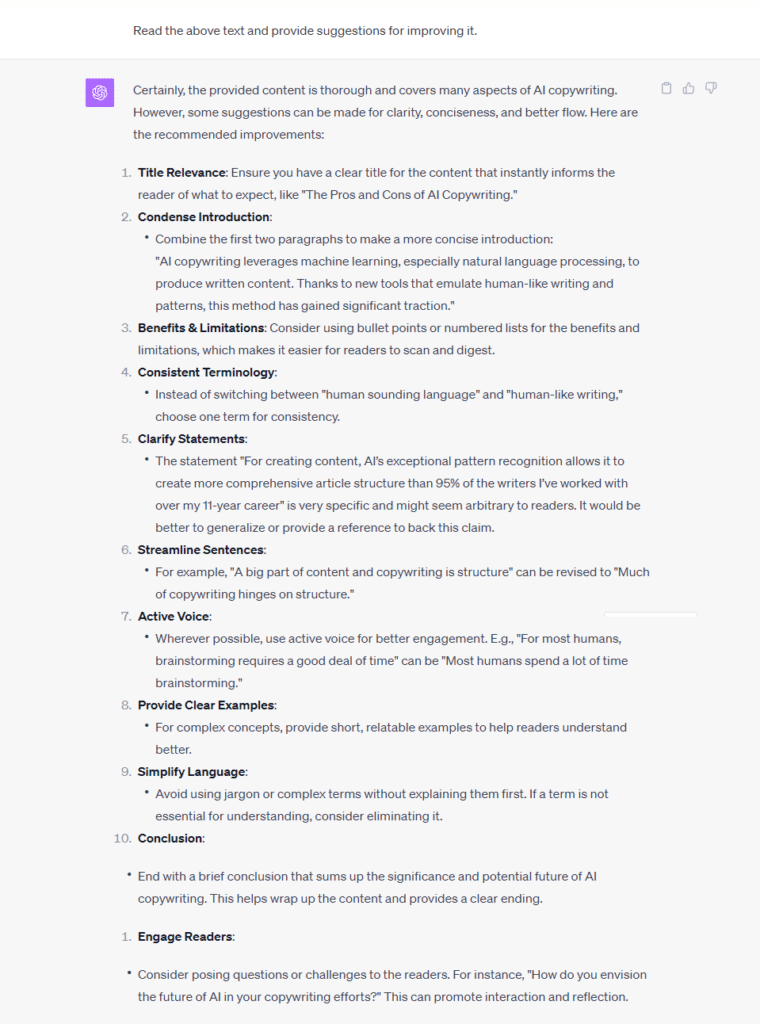
Not only does ChaGPT cover a lot of different issues that a good editor will look for:
- Consistent terminology
- Lack of sources for claims
- Active voice
- Lack of clear examples
- Lack of engaging questions
- Complex language or jargon
But you also immediately use ChatGPT to fix some of these issues.
For example, I could ask it to line item every place where I used passive voice instead of active voice, or I could simply ask it to rewrite the text and change passive voice to active voice (I prefer to line item, so that I can verify accuracy).
You can do the same thing for most of the editing suggestions, even using ChatGPT to add hypothetical questions or to flesh out a suggested personal story.
While ChatGPT cannot replace a great development editor — and I would encourage EVERY new copywriter to prioritize working with a great development editor — this is the first time in history where any copywriter can have a junior editor rapidly improving their work for just $20 per month.
That’s incredible. Take advantage of it!
Next Part: The Best AI Copywriting Tools
To read the next piece of this guide — a breakdown of the best AI copywriting tools available — signup below to receive a notification when it goes live (I’ll also send you my copywriting crash course, completely free).

